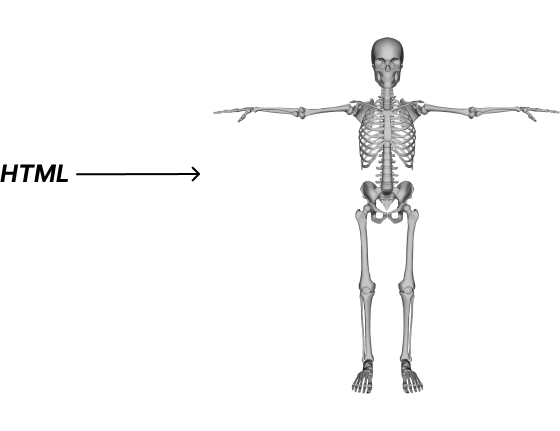What is HTML:
HTML, or Hypertext Markup Language, is the standard language used to create and design webpages. It is the fundamental building block of the World Wide Web, providing a structured and standardized way to present content. HTML uses a system of markup tags to define the elements within a webpage, allowing browsers to interpret and display information in a user-friendly format.

Description of HTML Example:
Consider the following example of a basic HTML document:
<!DOCTYPE html> <html lang="en"> <head> <meta charset="UTF-8"> <title>My First HTML Page</title> </head> <body> <h1>Hello, World!</h1> <p>This is a basic HTML document.</p> </body> </html>In this example:
- <!DOCTYPE html> declares the HTML version.
- <html lang="en"> is the root element of the HTML document.
- <head> contains meta-information about the document.
- <meta charset="UTF-8"> specifies the character encoding.
- <meta name="viewport" content="width=device-width, initial-scale=1.0"> sets the viewport for responsive design.
- <title> sets the title of the webpage.
- <body> contains the content, including an <h1> heading and a <p> paragraph.
This example illustrates the basic structure of an HTML document with key elements like headings, paragraphs, and meta-information.
HTML Version History:
1989-1991: HTML's Inception- Key Milestone: Sir Tim Berners-Lee proposes a system for sharing information among scientists at CERN.
- Significance:The concept of hypertext is born, laying the groundwork for HTML.
- Key Milestone:Introduction of the first HTML specification, known as HTML Tags.
- Features: Included 18 tags, such as <head>, <title>, <h1>, and <p>.
- Significance: Marks the beginning of HTML as a markup language.
- Key Milestone: HTML 2.0 is standardized by the Internet Engineering Task Force (IETF).
- Features: Introduces features like forms and tables.
- Significance:Sets the stage for HTML's wider adoption.
- Key Milestones:Key Milestones:
- Advancements: Brings advancements in style sheets, scripting, and multimedia support.
- Introduction of CSS: Cascading Style Sheets (CSS) introduced for enhanced design control.
- Key Milestone: Introduction of HTML 5.0, a major revision.
- New Features: Includes new semantic elements, multimedia support (audio and video), and enhanced scripting capabilities.
- Significance: Promotes a richer web experience, adapting to the evolving needs of the internet.
- Key Milestone:HTML5 becomes a W3C Recommendation.
- Emphasis: Solidifies its status as the standard for web development.
- Features: Emphasizes cross-platform compatibility and improved support for multimedia.
- Current Status:HTML continues to evolve with ongoing developments and refinements.
- Integration: Remains an integral part of web development, continually adapted to the needs of modern websites and applications.
The history of HTML is marked by a series of milestones, each contributing to the evolution of web development and the creation of a more dynamic and user-friendly online experience.
Features of HTML (Hypertext Markup Language):
- Markup Structure:
- HTML uses a markup structure with tags to define the elements on a webpage.
- Tags are enclosed in angle brackets, and elements consist of opening and closing tags with content in between.
- Cross-Platform Compatibility:
- HTML is designed to work consistently across different platforms and browsers, ensuring a uniform experience for users.
- Document Structure:
- HTML defines the structure of a document using elements such as headings (Hyperlinks are created using the (anchor) element, allowing users to navigate between different pages and resources.<h1> to <h6>), paragraphs (<p>), lists (<ul>, <ol>, <li>), and more.
- Hyperlinking:
- Hyperlinks are created using the Hyperlinks are created using the <a> (anchor) element, allowing users to navigate between different pages and resources.
- Image Embedding:
- The <img> element is used to embed images in a webpage, enhancing visual content.
- Forms and User Input:
- HTML includes form elements ( <form>, <input>, <select>, <textarea>) for user input and interaction.
- Semantic Elements:
- HTML5 introduces semantic elements (<header>, <nav>, <article>, <footer>) that convey the meaning and structure of content.
- Multimedia Support:
- HTML5 supports multimedia elements such as <audio< and <video<, allowing seamless integration of audio and video content.
- Responsive Design:
- HTML, in conjunction with CSS, enables responsive web design, ensuring that web pages adapt to different screen sizes and devices.
- Document Metadata:
- Metadata, including character set and viewport settings, is specified in the <head< section of an HTML document.
- Accessibility:
- HTML supports accessibility features, ensuring that web content can be navigated and understood by individuals with disabilities.
- Standardization:
- HTML is governed by the World Wide Web Consortium (W3C), ensuring standardization and adherence to best practices.
- Scripting Support:
- HTML allows the integration of scripts, such as JavaScript, for enhanced interactivity and dynamic content.
- Versioning:
- HTML versions, indicated by the <!DOCTYPE html> declaration, allow developers to specify the version of HTML being used.
- SEO-Friendly:
- HTML provides semantic markup, contributing to search engine optimization (SEO) by conveying the meaning and structure of content.
- Global Adoption:
- HTML is universally adopted and supported, making it the standard language for creating content on the World Wide Web.